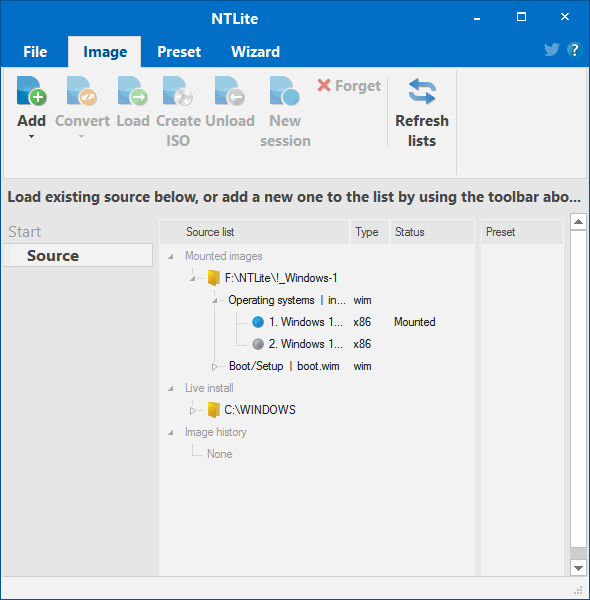Removing components and adjusting |
|
|
'NTlite' is a very powerful software, like a THOR's hammer. Author, Dino Nuhagić, also made a very powerful software 'nLite' for analyzing and rebuilding the Windows 2000, XP x86/x64 and 2003 x86/x64 operating systems. The 'nLite' is still available on the Internet. According to the statistics of viewing these pages, there are still users who use older operating system, and perhaps the first Nuhi work of this kind. Although at 'www.ntlite.com' there is a description of 'NTlite' software, and there is a forum and more useful content, the next animation is a brief overview of its capabilities.
 |
|
| Figure* 8. Part of NTLite capabilities. |
Of all the most interesting is the COMPATIBILITY window, because what is shown in it is used to analyze the contents of the installation media, remove or modify unwanted content, and then synthesize it into a new installation medium. Part of the expanded window above shows the next image.

|
| Figure 9. Removing OS components using NTLite. |
Figure 9 is the biggest picture I ever made at this site. It is shown on the page as broken, and click on the picture will show it in full size. Of course, it is made up of several unified images, and the complete window could only be available on monitors with a fairly large screen and very high resolution with rotation of 90°. In short, everything what to do is wiping the 'check' ( ✔ ) in the square with according name and description of the operating system component being considered. Shaded squares indicate that there are content with sub-squares without a check mark when dissolving the corresponding content. Deleted marks in a squares means that the corresponding terms will not be included in the new synthesized operating system content.
Why should some term be wiped out? Let's imagine that the operating system bunch of grain beans (files) each having a task. In order to carry out the task of certain grain bean, it is necessary to find and retrieve it. If a bunch of beans is smaller it is easier to find and retrieve the desired bean. Is there a 'Windows 10' excess grain beans? There is, and that's pretty. Here is a brief analysis of the 'Windows 10 x86 build 1511' operating system, which is used by the author of this site and his hints on doing the analysis.
When all this is done carefully, the content on the installation media will be reduced by over 30%. In particular, it will throw everything that belongs to HOME and does not need a PRO version of the operating system.
In order not to bother with certain operating system settings, some can be pre-defined according to the following picture:
 |
|
|
|
|
|
|
|
| Figure 10. Define OS settings using NTLite. |
But beware, the latter as far as control programs are concerned, Microsft simply ignores and solves only with wushowhide.diagcab according to Figure 4.6.61. Before installing live it is good to keep track of how it works on a virtual computer. Creating a new installation media is done by the 'Applay' action and the 'Process' button. During the synthesis, it is quite easy to see how it progresses in the appropriate views of the main window of 'NTlite' software.
SUMMARY:
Briefly, Software 'NTLite' serves to remove components in the composition OS installation media to the same extent by smaller, and thus the OS after installation is faster. Component removal was performed according to the computer configuration in 'Example II'.
This is a very useful software especially for system engineers who maintain a computer network, but this part is not described here. For this reason, you should contact the site of 'NTlite' and review its forum and FAQ, and the purchase will get secured support on any issue. Besides, Dino will accept and incorporate any smart suggestion, not to say that he regularly follows all of imaginations by Microsoft.
To install the operating system, the version 'Windows 10 v1511-x86' (udated vesion is 'v1511_2-x86') was selected because it proved to be the most stable and most suitable for older software. As a result, it is downloaded file from Microsoft's sites 'en_windows_10-multiple_editions-version_1511_x86-dvd_7223716.iso', size of 2'962'582 kB. The contents of this file are copied to the directory [!_Windows-1]. Than last cumulative update 'Win10_1511_x32_CU1177-kb4052232.msu' is downloaded from the Microsoft site, and its contents are unpacked into the [#W-update] directory. Then the 'NTLite' is used to embed new content in the [!_Windows-1] directory. When the installation of new content is complete, the entire [!_Windows-1] directory is copied to the [!_Windows-2] directory. Then the 'NTLite' in directory [!_Windows-2] removes all that is safe and without consequences on the operation of the OS is considered unnecessary. Then the reduced content from the [!_Windows-2] directory is copied to the [!_Windows-3] directory and additional careful reduction of the installation contents is performed, as well as adjustment of individual parameters and services, and the final value of the installation .ISO file is reduced to size 2'195'136 kB. If it is necessary to reduce the installation content, it can be done in even smaller steps at will (up to [!_Windows-X]) for accuracy, and it is easier to repeat the procedure in case of an error with fewer changes. It is good to check each change in 'VirtualBox'. After installation, according to the description in the final page of the 'Windows 10' operating system, the occupation of the installed operating system is 7'844'160 kB. You can view the list of removed content in the files that you can download here.
Use of 'NTLite' software and installation of 'Windows 10' operating system on a virtual computer made by software 'VirtualBox' (newer version) is described with 120 images in the file which can be downloaded here.
|
|
|
Citing of this page: Radic, Drago. " Informatics Alphabet " Split-Croatia. {Date of access}; https://informatics.buzdo.com/specific/file. Copyright © by Drago Radic. All rights reserved. | Disclaimer |